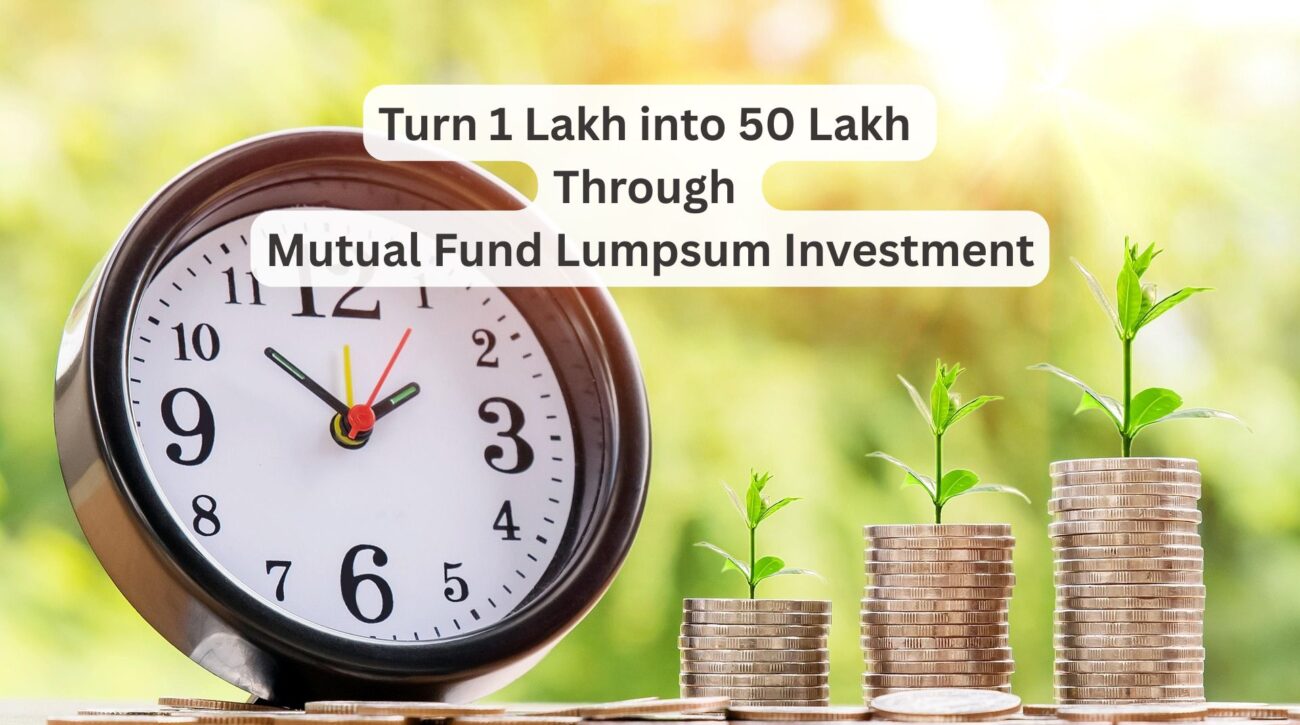Grow Rs 1 lakh into Rs 50 lakh via mutual fund lumpsum investment. Discover how long it takes at 11%, 15%, and 20% returns and make smarter financial decisions.
💡 Introduction
Imagine turning just Rs 1 lakh into Rs 50 lakh. Sounds too good to be true? With patience, discipline, and the power of compounding, this dream can become reality through mutual fund lumpsum investment for long-term corpus creation.
In this article, we’ll walk you through how a one-time Mutual fund lumpsum investment of Rs 1 lakh can grow into Rs 50 lakh. We’ll cover expected timeframes at different annual returns (11%, 15%, and 20%) and provide an investor-friendly roadmap with real insights and practical steps.
📊 How Power of Compounding Multiplies Your Wealth

The magic of compounding lies in letting your returns earn returns. Mutual funds, particularly equity funds, harness this power when you stay invested long-term. The growth is exponential not linear.
We use the standard compound interest formula:
A = P × (1 + r)ⁿ
Where:
- A = Final corpus
- P = Initial principal (₹1,00,000)
- r = Annual return rate
- n = Number of years
We want to find n, the time needed for Rs 1 lakh to grow to Rs 50 lakh.
⏳ At 11% Annual Return
Let’s solve:
- Final target: ₹50 lakh
- Initial investment: ₹1 lakh
- Growth needed: 50x
Using logarithmic math, it would take approximately 38.2 years to grow Rs 1 lakh into Rs 50 lakh at 11% CAGR.
Conclusion: It’s slow and steady, but consistent. If you start early, this is very much achievable.
🚀 What If Returns Are Higher?
Here’s a comparison of how the timeline shrinks as the annual return increases:
| Annual Return | Target (₹50L) | Years Required |
|---|---|---|
| 11% | ₹50 lakh | 38.2 years |
| 15% | ₹50 lakh | 27.0 years |
| 20% | ₹50 lakh | 20.2 years |
Even a 4% increase from 11% to 15% reduces your timeline by over 11 years. And if you’re able to earn 20%, you can reach the same goal nearly twice as fast.
Remember: Higher returns usually come with higher risk and market volatility.
⚖️ Risk vs Reward: What You Must Know
| Return Range | Fund Type | Risk Level |
| 11% | Diversified Equity Funds | Moderate |
| 15% | Mid-cap / Flexi-cap Funds | Medium to High |
| 20% | Sectoral / Thematic / Small-cap | High (for seasoned investors) |
- Equity mutual funds are not guaranteed to deliver fixed returns.
- Always match your investment horizon and risk appetite with the fund type.
💪 Strategy to Build ₹50 Lakh from ₹1 Lakh
- Start Early: Time is your best friend. The earlier you begin, the better.
- Choose Growth Option: Reinvests earnings to maximize compounding.
- Pick the Right Fund: Look for consistent performers, not just high past returns.
- Stay Invested Long-Term: Don’t panic during market downturns.
- Avoid Frequent Withdrawals: Every exit resets your compounding journey.
💼 Tax Implications You Should Know
- LTCG (Long-Term Capital Gains): Gains over ₹1 lakh after 1 year are taxed at 10%.
- STCG (Short-Term Capital Gains): If redeemed within a year, taxed at 15%.
- These taxes can slightly affect your final corpus but are relatively low compared to gains from compounding.
- Use growth option over dividend for long-term wealth building.
📆 Final Thoughts
Turning ₹1 lakh into ₹50 lakh may sound like a tall order, but with patience, smart planning, and the right mutual fund lumpsum investment for long-term corpus building, it’s not just a dream, it’s a mathematical possibility. Let compounding work silently in the background while you focus on your life goals.
🤔 FAQs

1. Can I really grow ₹1 lakh into ₹50 lakh?
Yes, with disciplined mutual fund lumpsum investment and long-term vision, it’s possible through the power of compounding.
2. Should I wait for the right time to invest?
No. Time in the market is better than timing the market. Start as early as possible.
3. Which mutual funds can give 15% to 20% returns?
Small-cap, mid-cap, and thematic funds have historically offered such returns, but they come with higher risk.
4. Is it better to invest lumpsum or via SIP?
If you have the amount ready, mutual fund lumpsum investment can start compounding earlier. SIPs help with market volatility.
5. Will inflation eat into my returns?
Yes, but equity mutual funds typically outperform inflation over long durations.
6. Are taxes going to reduce my final amount significantly?
Not drastically. Mutual funds enjoy favorable LTCG taxation, and growth is largely preserved.
7. Can I reach this goal sooner by adding SIPs later?
Absolutely. Combining SIP with lumpsum shortens your investment journey.
Disclaimer: Investing in mutual funds is subject to market risks. Consult your financial advisor before making any investment decision. Past performance is not indicative of future results.

